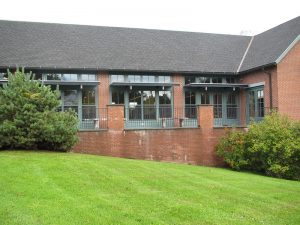In Day 2 of my western Connecticut prep school campus visits, I’m admittedly overwhelmed by the diversity of program offerings in this region. Connecticut is not a big state but is dense with prep schools. Today I visited Salisbury School, Indian Mountain School, and The Hotchkiss School.
SALISBURY SCHOOL
Salisbury serves 300 male students from around the world. The science center included a wonderful library, a physics lab, a chemistry lab, and a separate biology lab. My tour guide expressed that he wasn’t too keen on attending an all-boys school but realized that girls would be a distraction. Besides that, the school hosts dance each week so he’s still able to intermingle with girls socially.
The first stop on my tour was the boathouse, which is a sight to behold. It’s big, clean, and houses all the boats rowed by their world-class rowing program. An administrator proudly stated that “We grow rowers!” highlighting that many young men join the team with little to no experience. However, many advances to D1 level crew teams. The other athletic facilities were just as impressive . . . squash courts, hockey rink, lacrosse fields. Not to mention that their football team is strong in its division.
Salisbury understands boys, how to teach, how to engage, and how to nurture them both academically and socially.
INDIAN MOUNTAIN SCHOOL

Indian Mountain School is a junior boarding school that I was excited to visit in person. In my prior conversations with administrators, I sensed that it was a special place for students to develop into their own. The lower school has students in grades PK-4, while the upper school ushers students in grades 5-9 through early adolescence. Students will typically board in grades 7th, 8th, and 9th. For the teachers, administrators, and other staff, this really is a life commitment/decision. The responsibility is even greater in supporting these youth.
The team of adults who work there, live on campus, coach, and organize activities provide all the support services imaginable. The support services are balanced with student leadership opportunities. Students are given just as many opportunities to take risks. Each class experiences an outdoor adventure that bonds them in unforgettable ways. The overall thrust of the community was character development.
An administrator shared a quote in his office, which speaks to the character and quality of Indian Mountain School: “In all things, a lesson.”
THE HOTCHKISS SCHOOL

Hotchkiss is a school that you have to see to believe. Admittedly, I was overwhelmed by its campus size, facilities, and student involvement. A surprise day-off was announced prior to my arrival, so, as you can imagine, the students were happy and taking advantage of the many opportunities to order food, leave campus, or play games on the field.
The students I met were involved in so many activities – athletics, theatre, community service, as well as AP coursework. There are about 500+ students at Hotchkiss but its size rivaled most small colleges I’ve visited. An administrator described it as a “small school within a large school.”
From the science center to the fine arts offerings to the radio station to the Olympic-sized swimming pools to the school-owned farm, students have unlimited opportunities to explore and discover their interests. The academic rigor at Hotchkiss is well-known so students must learn fairly quickly how to balance their coursework with all these other enticing offerings.

